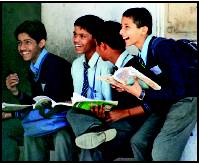
New Delhi: A day after Prathamís annual status of
education report (ASER) comes a comprehensive report
on elementary education by the National University
of Educational Planning and Administration that
shows spurt in enrolment, but a marginal decline
among Muslim, SC, ST and OBC students.
Across all social groups, enrolment of girls has
stabilized. But the sub-text of rise in overall
enrolment is that it is uneven across states. States
like Rajasthan and West Bengal have shown big
decline in enrolment. But, Delhi and Punjab have
shown dramatic increase in enrolment.
Enrolment in primary classes (I-V) has increased
to 13.52 crore from 13.34 crore in 2009-10. However,
in Rajasthan it came down to 84.32 lakh from 86.27
lakh (2009-10). On the contrary, in Punjab, it went
up to 25.63 lakh from 18.50lakh (2009-10). In upper
primary schools (class VI-VIII), enrolment has gone
up to 5.78 crore from 5.44 crore. Uttar Pradesh,
Bihar, Assam, Chhattisgarh and Tripura have shown
massive increase.
Enrolment of SC students in primary/upper
primary classes has come down marginally to 19.06%
from 19.81% (2009-10). Girls form nearly 49% of
theoverall SC enrolment. In case of STsí enrolment,
there is a negligible change of 10.7% from 10.93%
(2009-10). But OBC enrolment in primary level has
come down to 40.09% from previous yearís 42.15%.
There is a similar decline in upper primary classes
as well. A marginal dip can be noticed in enrolment
of Muslims in primary schools (13.04%) and upper
primary level (11.25%).
Confirming the ASER report, percentage of
government share to total schools has come down to
78.15% (2010-11) from 80.37 (2009-10). The report
says that between 2002-03 and 2010-11, 2.05 lakh new
government schools have opened, increasing the
density of primary schools per 10sq km to 3.45 from
3.35 (2009-10) and upper primary schools to 1.63
from 1.5 (2009-10).
For the first time, NUEPA survey also shows that
there are more recognized madarsas at 4,473 than
2167 unrecognized ones.